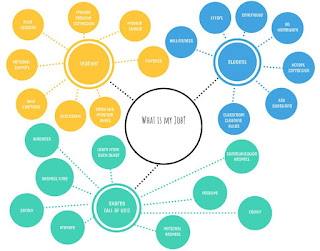TESL 0120: Unit 3 - Strategic Planning or Listening Instruction?
In the classroom we want to try to find ways to support scaffolding of student learning. The goal, of course, is that we want to help students understand that they already know many things and that what we are teaching (or they are learning) is building on that which they already know.
For the past two days, I have been away from work and home for board strategic planning. Part of our two day retreat was a session with a professor at Asper School of Business from the University of Manitoba around a concept called Mediating Assessments Protocol (MAP). The idea as I understand it, is that you put a measurable process in place for making strategic decisions rather than "going with your gut". It is about ensuring that you have the data to support making an appropriate decision, that you are looking for the counter intuitive, and not giving in to confirmation bias.
My learning this week has led me to a place where I am trying to synthesize the TESL and MAP concepts, with the goal of ensuring that I am better able to retain the ideas, and be more objective about how I approach both disciplines.
I am not sure that it is fully clear to me, but I wanted to share the idea that the MAP concept can be applied to how we work with listening and speaking assessment and correction. The four main ideas in the MAP process of decision making are:
For the past two days, I have been away from work and home for board strategic planning. Part of our two day retreat was a session with a professor at Asper School of Business from the University of Manitoba around a concept called Mediating Assessments Protocol (MAP). The idea as I understand it, is that you put a measurable process in place for making strategic decisions rather than "going with your gut". It is about ensuring that you have the data to support making an appropriate decision, that you are looking for the counter intuitive, and not giving in to confirmation bias.
My learning this week has led me to a place where I am trying to synthesize the TESL and MAP concepts, with the goal of ensuring that I am better able to retain the ideas, and be more objective about how I approach both disciplines.
I am not sure that it is fully clear to me, but I wanted to share the idea that the MAP concept can be applied to how we work with listening and speaking assessment and correction. The four main ideas in the MAP process of decision making are:
- Symptoms - we need to understand the symptoms of the problem and identify them before we start crafting solutions.
- Root Causes - we need to identify the causes; the symptoms are just that and may lead us to or away from the actual root cause - that is why we need to be on guard against seeking out limited data, we need to look beyond what seems to be right in front of us and we need to look for those things that might be counter intuitive.
- Problem framing - can we identify which problem or set of problems we are trying to solve? If we address this "one thing" are all the symptoms addressed and if not, why not? Is an outlier symptom its own problem?
- Solutions - once we know the above we can start sorting out and testing ideas that form the basis for solutions that we want to implement.
So, how does this mesh with TESL? Here are my links...
- Symptoms - We have spent considerable time in the past three weeks trying to find ways to identify learning areas that need support by FIRST identifying the symptoms of either speaking or listening challenges.
- Root Causes - we have discussed critical areas of causation that could be influencing the struggles that students face. Those may include areas such as L1 Interference, cultural behaviours, grammar, and more.
- Problem Framing - part of the above steps help us to identify what the difficulty really is so that we might frame the challenge appropriately, in order that we might determine how to proceed. If we do not identify the specific struggle (or struggles) of the individual learner it is unlikely that we would be able to support individual development. We must also be careful not to assume that all learners struggle with the same limitations, depending on the class dynamics, and therefore we must be prepared to work with problem framing from various vantage points at one time.
- Solutions - we have started to develop our understanding of how to provide developmental supports when there are specific problems identified. We have looked for ways to ensure that we are scaffolding student learning, and increasing personal awareness in the student in the process so that they might self-correct.
I think there is more in there that could be "MAP-ed" out, however I feel that this is a good start.
This has been a full week, and has been a challenging but positive experience. As I continue to synthesize my thoughts around this, I am thankful for my own development and feel that I have been able to scaffold my learning. If one of our goals as teachers is to empower our learners, my teachers have done a good job this week. I am feeling positive about my learning experiences and empowered for a next step.
References
Kahneman,D., Lovallo, D., Sibony, O. (2019) A structured approach to strategic decisions. MIT Sloan Management Review. Massachusetts Institute of Technology. Retrieved from

Comments
Post a Comment